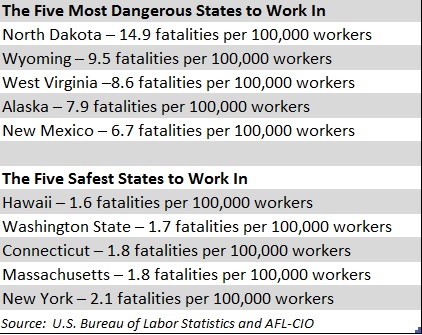For a long time, North Dakota was on a roll, fueled by a massive oil boom that doubled the state’s economic output in little more than a decade. The population surged, apartment and housing construction was out of sight, and the state was second only to Alaska in per capita Gross Domestic Product – or about $69,000 in economic activity per resident.
North Dakota hit another milestone in 2013—it was by far the most dangerous state in which to work. Before oil prices tanked, North Dakota had the highest work-related fatality rate in the nation – 14.9 per 100,000 workers or four times the national average, according to a new study by the AFL-CIO.
Related: The North Dakota Boom That’s Going Bust After Oil’s Plunge
Fifty-six workers were killed in North Dakota that year in work-related accidents. The fatality rate in the mining, and oil and gas extraction sectors was a shocking 84.7 per 100,000, or nearly seven times the national fatality rate in the industry. Meanwhile, the state’s construction sector fatality rate was 44.1 per 100,000, or more than four times the national rate.
 Four other states topped the list of the most dangerous places to work: Wyoming with 9.5 fatalities per 100,000 workers, West Virginia with 8.6 fatalities per 100,000, Alaska (7.9) and New Mexico (6.7).
Four other states topped the list of the most dangerous places to work: Wyoming with 9.5 fatalities per 100,000 workers, West Virginia with 8.6 fatalities per 100,000, Alaska (7.9) and New Mexico (6.7).
These fatality ratings constitute part of the dark underbelly of the oil, mining and construction industries and the high risks that Americans take every day in working in these industries.
By contrast, the lowest state fatality rate of 1.6 per 100,000 workers was reported in Hawaii, followed by Washington State (1.7), Connecticut and Massachusetts (1.8) and New York (2.1).
There are a number of factors that may contribute to the lower fatality rate in these states, including more aggressive union activity and oversight in the work place, according to the AFL-CIO.
Over the past four years, the job fatality rate across the country has declined slightly each year, with a rate of 3.3 deaths per 100,000 workers in 2013 compared with a rate of 3.6 per 100,000 workers in 2010.
Still, a total of 4,585 workers were killed on the job in the United States in 2013, according to the 2015 edition of the AFL-CIO’s Death on the Job: The Toll of Neglect, while an estimated 50,000 died from occupational related diseases.
Related: Dark Side of North Dakota’s Oil Boom
At the same time, nearly 3.8 million work-related injuries and illnesses were also reported, but many injuries are not reported. Peg Seminario, Director of Safety and Health, AFL-CIO, said in a conference call on Wednesday that the latest figures document both the terrible human and economic toll that work place deaths and serious injuries extract from businesses, the government and average Americans.
“It’s a huge problem that continues,” she said. “The cost estimates are in the range to $250 billion to $360 billion a year. And we also know that the majority of those costs are borne by workers and their families themselves. So the impact and the toll are tremendous and significant.”
Related: Dying to Work: On-the-Job Fatalities Are Rising
Among other findings:
- Sixty-six percent of the fatalities (542 deaths) in 2013 were among workers born outside the United States. There were 817 Latino workers killed on the job in 2013, up from 748 deaths in 2012.
- For women, the leading causes of death at work were roadway incidents (28%), homicide (21%) and falls (12%). Homicides in the workplace continue to be a disproportionate cause of death for women (21%) compared with men (8%).
- Contractors accounted for 16 percent of all worker fatalities in 2013, or 749 deaths. Construction and extraction workers accounted for half of these deaths. Thirty-five percent of contract workers who died in the construction industry were actually contracted to another industry when they died. Temporary workers and other contract workers often work in dangerous jobs, with no safety and health protections or training.
Seminario praised the work of the federal Occupational Safety and Health Administration (OSHA) and the state OSHA programs, but said they have limited resources and massive responsibility.
There are 847 federal and 1,035 state inspectors responsible for overseeing eight million workplaces under their jurisdiction. This means there is one inspector for every 71,695 workers.
Top Reads from The Fiscal Times:





